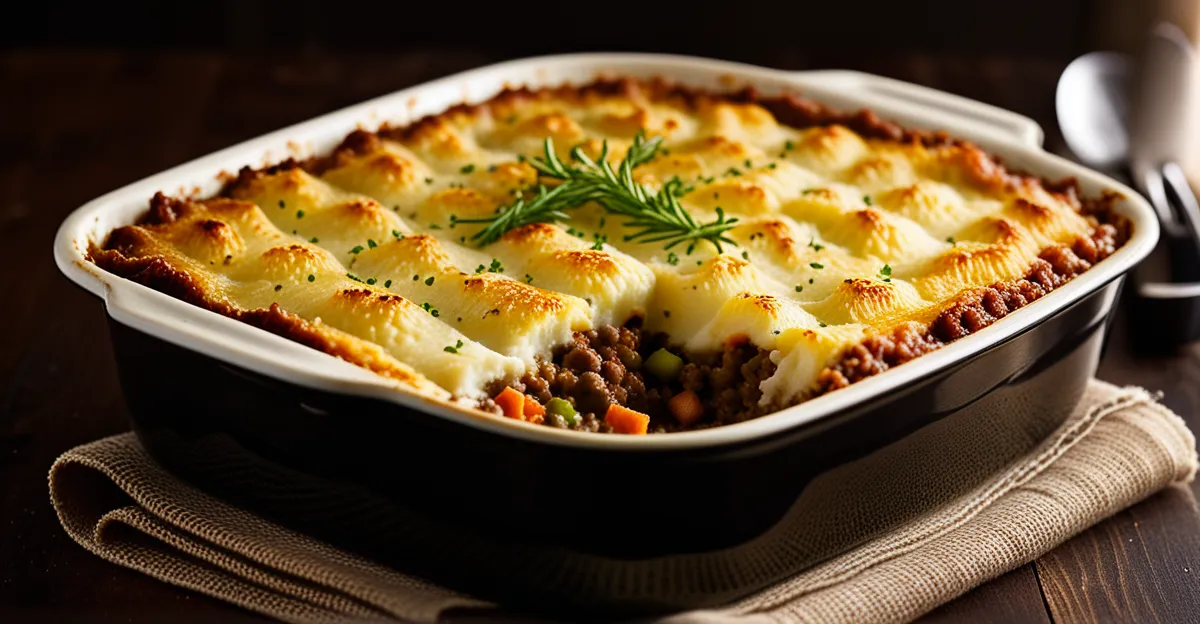Understanding Shepherd’s Pie
The rich tapestry of Shepherd’s pie is interwoven with history, cultural nuances, and a strong identity as a beloved comfort food. Originating in the UK, this dish traditionally consists of minced lamb topped with a layer of creamy mashed potatoes. Its comforting nature makes it a staple in many households.
Origins and Traditional Components
The classic Shepherd’s pie embodies simplicity, with core ingredients like minced lamb, vegetables such as peas and carrots, and a savory gravy. Mashed potatoes not only provide a contrasting texture but also represent its traditional character. Initially crafted using leftover roasted meat, this dish emphasizes both frugality and creativity.
Also to read : How can you master the art of making a proper Scotch egg?
Regional Variations
Across regions, there are intriguing variations using distinct local ingredients. In some areas, beef replaces lamb, often referred to as “Cottage Pie.” Unique tweaks might include replacing mashed potatoes with a sweet potato topping or incorporating local vegetables. Each variation reflects regional tastes, adapting the dish’s core to new palates.
Comfort Food Culture
In the realm of comfort food, Shepherd’s pie holds a special place. It is a dish associated with warmth, homeliness, and gatherings, often evoking nostalgia. The hearty flavors and textures make it a favored choice during colder months, bonding people through shared culinary experiences.
Also to see : How can you make a deliciously creamy Eton mess?
Creative Flavor Variations
Transforming the classic Shepherd’s pie into a culinary innovation can be both exciting and rewarding. This can be achieved by experimenting with unique ingredients and enhancing flavors creatively.
Incorporating Unconventional Ingredients
To break away from tradition, consider substituting the typical lamb or beef with proteins like turkey, chicken, or even lentils for a protein-packed vegetarian option. These variations not only cater to dietary preferences but also introduce new textures and flavors. For a vegan twist, try using tofu or seitan, seamlessly paired with a variety of vegetables for a satisfying meal. Experiment with toppings by using crushed nuts or crispy breadcrumbs to add a delightful crunch.
Using Flavorful Sauces and Broths
Elevating your Shepherd’s pie starts at the base. Enhance the filling with robust sauces such as a rich red wine reduction or a tangy tomato glaze. Choosing between homemade and store-bought broths can significantly influence the flavor profile; while homemade offers personalization and depth, store-bought is convenient. Incorporate herb and spice combinations like rosemary, thyme, and smoked paprika for an aromatic boost, transforming a simple pie into a gourmet delight.
Experimenting with Seasonal Vegetables
Incorporating seasonal produce not only supports sustainability but also infuses fresh flavors. Roasting winter root vegetables, such as parsnips and sweet potatoes, enhances their natural sweetness and depth. Summer selections may include zucchini and fresh peas, adding brightness and color. Cooking methods—like roasting or sautéing—can heighten these ingredients’ flavors, while spices such as cumin or coriander can create harmonious and exotic profiles when paired with complementary vegetables.
Step-by-Step Recipe for a Unique Shepherd’s Pie
To create a flavorful shepherd’s pie that sets itself apart, attention to detail in ingredients and preparation is crucial. Let’s dive into crafting a delightful variation of this classic dish.
Detailed List of Ingredients
- 500g minced lamb or beef
- 1 onion, finely chopped
- 2 carrots, diced
- 100g peas
- 2 cloves garlic, minced
- 2 tablespoons tomato paste
- 300ml beef broth
- 1 teaspoon Worcestershire sauce
- 1 tablespoon fresh rosemary, chopped
- Salt and pepper to taste
- 1kg potatoes, peeled and quartered
- 60g butter
- 100ml milk
- Optional topping: 1/4 cup grated cheese
Comprehensive Preparation Steps and Cooking Times
-
Preparation: Preheat your oven to 200°C (400°F). Begin with boiling the potatoes in salted water for about 20 minutes until tender. Drain and mash with butter and milk to achieve a creamy consistency.
-
Cooking the filling: In a large skillet, sauté the onions and garlic over medium heat until softened. Add the carrots and cook for another 5 minutes. Incorporate the minced lamb (or beef) and cook until browned.
-
Flavor development: Stir in the tomato paste, beef broth, Worcestershire sauce, and rosemary. Let the mixture simmer for about 15 minutes or until slightly thickened. Season with salt and pepper.
-
Assembly and baking: Place the meat mixture into a baking dish, evenly spreading mashed potatoes on top. Sprinkle with grated cheese if desired. Bake in the oven for 25-30 minutes, until the top is golden and bubbling.
Tips and Tricks for Achieving the Perfect Texture and Taste
- Creamy potatoes: For an extra smooth mash, consider adding a touch more butter or milk based on your desired texture.
- Enhanced flavor: Adding a splash of red wine or a dash of smoked paprika to the meat mixture can infuse additional depth.
- Golden topping: To ensure a crispy top layer, brush the potatoes with a bit of melted butter before baking.
By integrating these suggestions, you’ll perfect the art of preparing this comfort food staple, ensuring a memorable dining experience.
Serving Suggestions and Pairings
When serving Shepherd’s pie, the experience can be elevated with thoughtful accompaniments and creative presentations. These additions not only enhance the visual appeal but also balance the robust flavors of this comforting dish.
Ideal Side Dishes
To complement the hearty nature of Shepherd’s pie, consider side dishes that offer contrasting textures and flavors. A light green salad with a zesty vinaigrette provides a refreshing contrast to the richness of the pie. Alternatively, steamed green beans or roasted Brussels sprouts can add a crisp edge to the meal, providing a delightful interplay of tastes. For a comforting twist, buttery dinner rolls can be an ideal side, soaking up the savory gravy and enhancing the dining experience.
Creative Serving Ideas for Special Occasions
On special occasions, transform Shepherd’s pie into a centerpiece by presenting it in individual ramekins for each guest. This not only personalizes the serving but also ensures a perfectly portioned meal. For an elevated presentation, consider piping the mashed potato topping in a decorative pattern, adding a touch of elegance to the dish. Garnishing with fresh herbs such as rosemary or parsley can also add a burst of color and aroma, elevating the overall presentation.
Presenting the Dish for Visual Appeal
Visual appeal is key in making Shepherd’s pie not just a meal, but an experience. Layering the ingredients ensures distinct, defined layers when serving, offering a feast for the eyes. Opt for white or colored bakeware to create a striking contrast with the golden potato topping. For added depth, drizzle a reduced balsamic glaze around the plate just before serving. These subtle touches enhance the appeal and make the dish truly memorable.
Personal Anecdotes and Cultural Influences
Shepherd’s pie transcends its humble beginnings, often bearing a tapestry of personal recipes and cultural flourishes. The dish’s adaptability is a testament to its enduring place in global kitchens.
Family Recipes and Their Stories
In some families, Shepherd’s pie takes on new life, reflecting generations of shared culinary journeys. A cherished personal recipe may feature a secret spice blend or a method passed down through the years, lending depth and warmth to each bite. Cultural heritage can play a significant role in these variations; perhaps the spices chosen are a nod to ancestral roots or familial ties. At gatherings, as each mouthful stirs memories, shepherd’s pie becomes more than a dish—it’s a thread connecting past to present, tradition to innovation.
Global Inspirations
The beauty of Shepherd’s pie lies in its universality. Across the globe, chefs reimagine this comfort food staple with ingredients and techniques unique to their region. In India, a spiced lentil-filling may mirror the traditional flavors of curry, while in Italy, a rich tomato base infuses Mediterranean flair. By blending these global inspirations, one can transform the classic without losing its soul. Each iteration is an invitation to explore new horizons, marrying tradition with the diverse tapestry of world cuisines.






